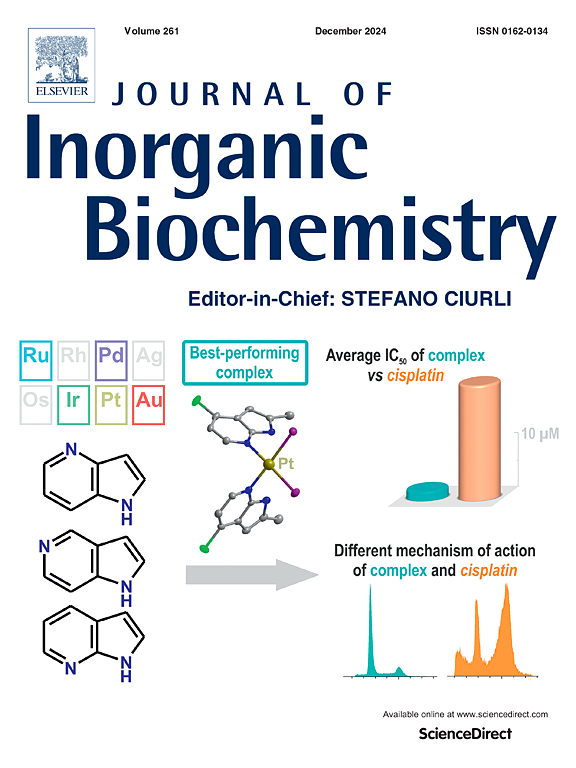Bioinspired copper(II) complexes catalyzed oxidative coupling of aminophenols with broader substrate scope
IF 3.2
2区 化学
Q2 BIOCHEMISTRY & MOLECULAR BIOLOGY
引用次数: 0
Abstract
The strategic selection of ligand systems in metal complexes has demonstrated a profound impact on the efficiency and specificity of biomimetic reactions. In this work, we introduce a series of aminoquinoline-based copper(II) complexes (1–4) distinguished by systematic variation in terminal amine substituents: di-n-methyl (L1(H)), di-n-ethyl (L2(H)), di-n-propyl (L3(H)), and di-n-butyl (L4(H)). These complexes are synthesized, characterized, and evaluated as the catalyst for the oxidative coupling of different aminophenol derivatives. Remarkably, complex 1, featuring a methyl substituent, exhibited unparalleled catalytic performance, achieving an 86 % (Kcat - 9.7 × 104 h−1) conversion of o-aminophenol to the desired product, 2-amino-phenoxazin-3-one, alongside water and hydrogen peroxide as byproducts. Notably, complex 1 demonstrated exceptional versatility, extending its catalytic activity to other substrates with remarkable activity. Mechanistic investigations, supported by mass-spectrometric analysis, revealed the formation of a complex-substrate adduct with all substrates, enabling us to propose a detailed reaction pathway. The work highlights the benefits of ligand design in improving catalytic performance and sets a new standard for aminoquinoline-based copper(II) complexes in oxidative coupling reactions. To the best of our knowledge, this work is the first to report a wider substrate scope for PHS activity with copper(II) complexes.

生物激发铜(II)配合物催化氨基酚的氧化偶联具有更广泛的底物范围
金属配合物中配体系统的策略性选择对仿生反应的效率和特异性有着深远的影响。在这项工作中,我们介绍了一系列基于氨基喹啉的铜(II)配合物(1-4),这些配合物通过末端胺取代基的系统变化而有所区别:二-正甲基(L1(H))、二-正乙基(L2(H))、二-正丙基(L3(H))和二-正丁基(L4(H))。这些配合物作为不同氨基苯酚衍生物氧化偶联的催化剂进行了合成、表征和评估。值得注意的是,以甲基取代基为特征的复合物 1 表现出了无与伦比的催化性能,它能将邻氨基苯酚转化为所需产物 2-氨基苯并恶嗪-3-酮,转化率高达 86%(Kcat - 9.7 × 104 h-1),同时副产物为水和过氧化氢。值得注意的是,复合物 1 表现出了非凡的多功能性,其催化活性可扩展到其他底物,且活性显著。在质谱分析的支持下进行的机理研究发现,所有底物都会形成复合物与底物的加合物,从而使我们能够提出详细的反应途径。这项工作凸显了配体设计在提高催化性能方面的优势,并为氧化偶联反应中的氨基喹啉基铜(II)配合物设定了新标准。据我们所知,这项研究首次报告了铜(II)配合物在 PHS 活性方面更广泛的底物范围。
本文章由计算机程序翻译,如有差异,请以英文原文为准。
求助全文
约1分钟内获得全文
求助全文
来源期刊

Journal of Inorganic Biochemistry
生物-生化与分子生物学
CiteScore
7.00
自引率
10.30%
发文量
336
审稿时长
41 days
期刊介绍:
The Journal of Inorganic Biochemistry is an established international forum for research in all aspects of Biological Inorganic Chemistry. Original papers of a high scientific level are published in the form of Articles (full length papers), Short Communications, Focused Reviews and Bioinorganic Methods. Topics include: the chemistry, structure and function of metalloenzymes; the interaction of inorganic ions and molecules with proteins and nucleic acids; the synthesis and properties of coordination complexes of biological interest including both structural and functional model systems; the function of metal- containing systems in the regulation of gene expression; the role of metals in medicine; the application of spectroscopic methods to determine the structure of metallobiomolecules; the preparation and characterization of metal-based biomaterials; and related systems. The emphasis of the Journal is on the structure and mechanism of action of metallobiomolecules.
 求助内容:
求助内容: 应助结果提醒方式:
应助结果提醒方式:


